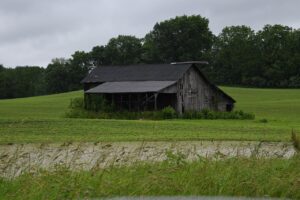Best Way to Find Abandoned Farms for Sale
Picture this: a sprawling piece of land, once teeming with life and activity, now abandoned and forgotten. The thought may evoke a sense of mystery and curiosity. What stories lie within those dilapidated barns? What dreams were forged on that weathered porch? Abandoned farms possess a unique allure that captivates the imagination of many. But beyond their romantic appeal, these forgotten properties offer opportunities for those seeking new beginnings or sustainable living.
This post will delve into the world of abandoned farms for sale. We will explore the benefits and challenges associated with purchasing such properties and provide you with practical steps to uncover hidden gems in rural landscapes. Whether you’re an aspiring farmer or drawn to the charm of rustic living, read on to discover how you can find your slice of history amidst the rolling hills and open fields.
So grab your metaphorical explorer’s hat – it’s time to embark on a journey through time and land as we uncover the secrets of abandoned farms waiting to be rediscovered!
Understanding the Appeal of Abandoned Farms
There is an unmistakable allure in the story of abandoned farms. These forgotten plots of land capture our imagination and leave us yearning for a connection to the past. The appeal lies in their untamed beauty, with nature reclaiming what was once meticulously cultivated by human hands.
Abandoned farms offer a glimpse into a simpler time when life revolved around the rhythm of seasons and hard work. They evoke nostalgia for an era when self-sufficiency was revered and communities were tightly knit. There is something inherently romantic about breathing new life into these neglected spaces, restoring them to their former glory while preserving their unique character.
For some, the appeal stems from a desire to escape the hustle and bustle of modern life. Abandoned farms provide an opportunity to disconnect from technology and reconnect with nature’s rhythms. Living off the land can be immensely rewarding – cultivating crops, raising livestock, or even starting small-scale sustainable businesses on these properties allows individuals to forge a deeper connection with their surroundings.
Furthermore, abandoned farms often have breathtaking landscapes that inspire awe and tranquility. Rolling hills, meandering streams, and majestic old-growth trees create a sense of peace that is increasingly elusive in our fast-paced world.
The appeal stretches beyond aesthetics; there’s also immense satisfaction in revitalizing forgotten spaces with historical significance within local communities. By purchasing an abandoned farm, you become part of its narrative – preserving its legacy and creating your chapter.
Intriguingly mysterious yet undeniably captivating – abandoned farms embody history’s echoes and future possibilities awaiting those willing to embrace them wholeheartedly. So, if you’re ready for adventure amidst rustic charm or seeking solace amongst nature’s embrace – consider exploring the hidden treasures within these enchanting realms!
Benefits and Challenges of Buying an Abandoned Farm
The benefits and challenges of buying an abandoned farm can be both exciting and daunting. On one hand, the potential to create a new life in a picturesque rural setting is enticing. There’s the opportunity to live off the land, grow your food, and embrace a more straightforward way of life. It also comes with the chance to restore a piece of history, breathing new life into old buildings that hold stories from generations past.
However, it’s essential to recognize the challenges of purchasing an abandoned farm. First and foremost is the extensive work required for renovation and restoration. Abandoned farms often need significant repairs and updates to meet modern standards. This can include everything from fixing structural issues to updating plumbing, electrical systems, and more.
Additionally, unforeseen costs may be associated with purchasing an abandoned farm, such as environmental cleanup or zoning restrictions that could limit certain activities on the property.
Despite these challenges, many people find immense satisfaction in restoring abandoned farms. The sense of accomplishment from transforming dilapidated buildings into functional spaces is unparalleled. Living in a rural area offers peace and tranquility not easily found elsewhere.
If you’re considering buying an abandoned farm, make sure you carefully weigh both the benefits and challenges before making your decision. Researching the property’s history and condition thoroughly is essential to clearly understand what you’re getting into. And remember – while renovating an abandoned farm may be hard work initially, it can ultimately lead to a rewarding lifestyle surrounded by nature’s beauty!
Steps to Finding Abandoned Farms for Sale
When it comes to finding abandoned farms for sale, there are several steps you can take to increase your chances of success. The first step is to research and gather information about potential properties thoroughly. Start by searching online real estate listings and websites specializing in rural properties.
Next, contact local real estate agents who may know of abandoned farms in the area. They can help you navigate the complex process of buying an abandoned property and provide valuable insights into the local market.
Once you have identified a few potential options, it’s time to visit the farms in person. Take note of their location, size, and condition. Look for signs of neglect or damage that may require extensive repairs or renovations. 
After assessing the condition of each farm, it’s crucial to conduct a title search and investigate any outstanding liens or legal issues associated with the property. This will ensure that you know any potental obstacles before making an offer.
When negotiating with sellers, be prepared to make reasonable offers based on your research and assessments. Remember that purchasing an abandoned farm comes with challenges but also presents unique opportunities for those willing to put in the effort.
Following these steps diligently and staying patient throughout the process will increase your chances of finding a hidden gem among abandoned farms for sale! So roll up your sleeves and start exploring – your dream farm might be just around the corner!
Researching the Property and its History
Researching the property and its history is crucial when looking for abandoned farms for sale. It not only helps you understand the background of the property but also gives valuable insights into its potential value and any potential challenges that may arise.
To begin your research, gather as much information as possible about the farm. Look for documents such as land deeds, tax records, and previous sales listings. These can provide details about ownership history, boundaries, and any liens or encumbrances on the property.
Next, visit your local county courthouse or historical society to dig deeper into the farm’s past. Look for old photographs, maps, or newspaper articles that shed light on its former use or significance in the community. This can be a fascinating way to uncover hidden stories behind abandoned farmland.
It’s also important to consider environmental factors when researching an abandoned farm. Check if any nearby hazardous waste sites or environmental restrictions could affect your redevelopment plans.
Also, talk to locals who know about the area or neighboring properties. They may have valuable information about why the farm was abandoned in the first place or insights into potential challenges you may face during renovation.
Thorough research will help you make informed decisions before purchasing an abandoned farm. Understanding its history and context within legal and environmental frameworks, you’ll be better equipped to assess its actual value and potential future use!
Assessing the Condition of the Farm
Assessing the condition of the farm is a crucial step in the process of buying an abandoned property. It allows you to determine the extent of repairs and renovations that may be necessary, as well as estimate the overall cost involved.
It’s crucial to inspect the entire property physically. Take note of any damage or deterioration in structures such as barns, sheds, and houses. Look for signs of water damage, structural issues, or pest infestations. This will give you a better understanding of what must be repaired or replaced.
Additionally, assess the land itself. Are there any areas that need clearing? Is there access to water sources for irrigation purposes? Consider factors such as soil quality and topography if you intend to use the land for agriculture.
Don’t forget about utilities! Check if electricity and plumbing are still functional or need significant upgrades. These aspects will help you gauge how much work needs to be done before you can comfortably live on or utilize the farm.
Engage professionals like contractors and inspectors who specialize in assessing old properties. Their expertise can provide valuable insights into potential issues that may take time to be apparent.
Remember, assessing the condition of an abandoned farm requires careful observation and expert advice. By thoroughly evaluating its state before purchase, you’ll have a clearer picture of what lies ahead on your journey toward restoring this forgotten gem back to life!
Negotiating and Closing the Deal
Negotiating and closing the deal for an abandoned farm can be thrilling yet challenging. As you navigate through this stage, keeping a few key things in mind is essential.
Make sure you have done thorough research on the property and its value. This will give you a solid foundation for negotiating with the seller. Understand what similar properties in the area are selling for and use that information as leverage during your discussions.
When entering negotiations, approach them with a clear strategy in mind. Decide on your maximum budget and desired terms ahead of time so that you can negotiate confidently. Be prepared to compromise, but also stick to your non-negotiables
It’s crucial to enlist the help of professionals such as real estate agents or lawyers who specialize in rural properties. They will guide you through the negotiation process, offer advice, and ensure all legal aspects are handled.
Once both parties agree on terms, closing the deal is time. This involves finalizing contracts, conducting inspections if necessary, securing financing if needed, and completing any other required paperwork.
Remember that patience is critical during this phase, as there may be various hurdles to overcome before officially sealing the deal. Stay organized by keeping track of deadlines and communicating effectively with all parties involved.
Tips for Renovating an Abandoned Farm
Renovating an abandoned farm can be a rewarding and fulfilling endeavor. It allows you to breathe new life into the property while preserving its historical charm and character. However, it’s essential to approach the renovation process with careful planning and consideration.
Before diving into any renovations, thoroughly assess the condition of the farm. This will help you prioritize which areas need immediate attention and create a realistic budget for your project. Look for structural issues such as roof damage or foundation problems requiring professional assistance.
Once you have identified the necessary repairs, hire qualified contractors specializing in historic renovations. They will understand how to preserve unique features like exposed beams or original flooring while ensuring modern functionality.
Additionally, consider sustainability when renovating your abandoned farm. Implement eco-friendly practices such as installing energy-efficient appliances or incorporating solar panels to reduce utility costs over time.
Furthermore, use local resources such as salvage yards or antique shops when sourcing materials for your renovation project. This can add a touch of authenticity and uniqueness to your farm’s restoration.
Don’t forget about landscaping! Enhancing the outdoor spaces around your renovated farm can significantly increase its curb appeal. Consider creating gardens or planting fruit trees that complement the surrounding natural beauty.
Renovating an abandoned farm requires careful planning, skilled professionals, sustainable practices, resourcefulness in material sourcing, and attention to detail both indoors and outdoors.
Finding and purchasing an abandoned farm can be thrilling for those seeking adventure and the opportunity to restore a piece of history. While it may come with its fair share of challenges, the benefits of owning an abandoned farm are abundant.
The appeal lies in the potential for creating a unique home or business space while preserving the heritage and character of these forgotten properties. You can turn an abandoned farm into a beautiful sanctuary or thriving enterprise with proper research, assessment, negotiation skills, and renovation efforts.
Remember to take your time when searching for abandoned farms for sale. Explore resources such as online listings, local real estate agents, auctions, and networking within farming communities. Be patient during your property research phase to uncover hidden histories or potential issues that could impact your decision.
Once you find a prospective property, thoroughly assess its condition by conducting inspections and engaging experts if necessary. This step will help you determine the extent of renovations needed and estimate the costs involved accurately.
Negotiating with sellers is essential to get the best deal possible on your desired abandoned farm. Seek legal advice if required during this process to protect your interests fully.
Renovating an abandoned farm requires careful planning and execution. Consider hiring professionals specializing in historic restoration or agricultural development to assist with bringing new life back into these neglected spaces.
In conclusion,
Abandoned farms for sale offer unique opportunities for those willing to embrace their inherent challenges. By following these steps outlined above – from researching properties’ history through negotiating deals to shaping them anew – individuals can transform dilapidated structures into flourishing havens again! So don’t hesitate; start exploring today!



